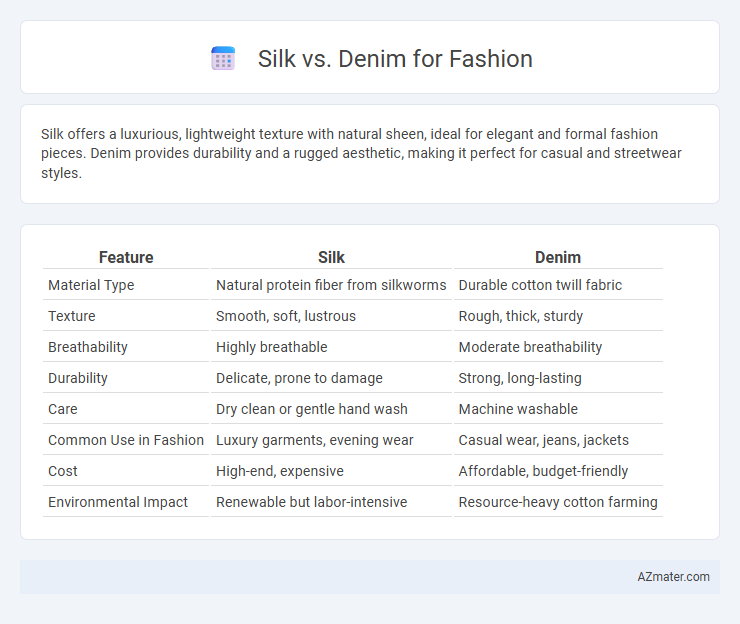Silk offers a luxurious, lightweight texture with natural sheen, ideal for elegant and formal fashion pieces. Denim provides durability and a rugged aesthetic, making it perfect for casual and streetwear styles.
Table of Comparison
| Feature | Silk | Denim |
|---|---|---|
| Material Type | Natural protein fiber from silkworms | Durable cotton twill fabric |
| Texture | Smooth, soft, lustrous | Rough, thick, sturdy |
| Breathability | Highly breathable | Moderate breathability |
| Durability | Delicate, prone to damage | Strong, long-lasting |
| Care | Dry clean or gentle hand wash | Machine washable |
| Common Use in Fashion | Luxury garments, evening wear | Casual wear, jeans, jackets |
| Cost | High-end, expensive | Affordable, budget-friendly |
| Environmental Impact | Renewable but labor-intensive | Resource-heavy cotton farming |
Introduction: Comparing Silk and Denim in Fashion
Silk and denim represent two iconic fabrics in fashion, each with unique textures and cultural significance. Silk, known for its smooth, luxurious feel and natural sheen, is favored in high-end, elegant apparel, while denim offers durability and a casual, rugged aesthetic popular in everyday wear. The contrast between silk's delicate softness and denim's sturdy structure highlights their distinct roles in fashion design and consumer preferences.
Historical Evolution of Silk and Denim
Silk, originating in ancient China around 2700 BCE, was historically prized for its luxurious texture and status symbol among royalty and nobility, evolving into a global trade commodity via the Silk Road. Denim, developed in the late 19th century in the United States, began as durable workwear fabric for miners and laborers before transforming into an iconic symbol of casual and rebellious fashion worldwide. The distinct historical trajectories of silk and denim highlight their contrasting roles in fashion, from opulence and heritage to practicality and cultural expression.
Fabric Production Processes: Silk vs Denim
Silk production begins with sericulture, where silkworms spin cocoons that are carefully harvested and boiled to extract long, smooth fibers, resulting in a luxurious, lightweight fabric. Denim is woven from sturdy cotton yarns, primarily produced through spinning, dyeing with indigo, and twill weaving to create its distinctive durability and textured finish. The intricate natural process of silk contrasts with denim's industrial, mechanical production, influencing their respective qualities and applications in fashion.
Texture and Feel: Comfort Differences
Silk offers a smooth, luxurious texture that feels cool and lightweight against the skin, making it ideal for breathable luxury fashion. Denim provides a sturdy, rougher texture with a heavier weight, offering durability and a more casual, rugged comfort. The choice between silk and denim significantly affects the overall sensory experience, balancing softness and breathability versus toughness and structure.
Style Versatility in Fashion Outfits
Silk offers a luxurious, smooth texture and elegant drape that enhances formal and evening wear, making it ideal for sophisticated blouses, dresses, and scarves. Denim provides rugged durability and casual appeal, perfect for versatile pieces like jeans, jackets, and skirts that can be styled from streetwear to smart-casual looks. Combining silk and denim in fashion outfits delivers a dynamic contrast of soft elegance and sturdy practicality, expanding style versatility across diverse occasions.
Durability and Maintenance Requirements
Silk offers a luxurious feel and elegant appearance but has lower durability compared to denim, as it is prone to tearing and damage from abrasion. Denim, known for its ruggedness and longevity, withstands frequent wear and washing, making it ideal for everyday fashion requiring minimal maintenance. Maintenance of silk involves delicate hand washing or dry cleaning to preserve its texture, while denim can be machine washed with less concern for fabric degradation.
Seasonal Suitability: Silk vs Denim
Silk offers superior breathability and moisture-wicking properties, making it an excellent choice for warm-weather fashion due to its lightweight and cooling effect. Denim, known for its durability and heavier weight, provides better insulation, which suits cooler seasons by retaining heat and resisting wind. Choosing between silk and denim depends largely on seasonal needs, with silk favored for summer and spring attire and denim preferred during fall and winter.
Sustainability and Environmental Impact
Silk production involves natural fibers from silkworms, making it biodegradable but often resource-intensive due to water use and mulberry cultivation. Denim, primarily made from cotton, has a substantial environmental footprint linked to high water consumption, pesticide use, and chemical dyeing processes. Sustainable fashion trends favor organic cotton denim and peace silk alternatives to reduce ecological impact while maintaining durability and style.
Price Point and Affordability
Silk fabric typically commands a higher price point due to its luxurious texture and natural production process, making it less affordable for everyday wear compared to denim. Denim, crafted from cotton and known for its durability and versatility, offers a wide range of price options, often making it a budget-friendly choice for consumers. Fashion buyers seeking cost-effective yet stylish materials often prefer denim for casual and streetwear collections, whereas silk is reserved for premium, high-end fashion pieces.
Conclusion: Choosing Between Silk and Denim
Choosing between silk and denim depends on the desired style and occasion, as silk offers a luxurious, smooth texture ideal for formal wear, while denim provides durability and a casual, rugged aesthetic perfect for everyday outfits. Silk garments excel in elegance and breathability but require delicate care, whereas denim is known for its resilience and easy maintenance. Evaluating comfort, versatility, and garment care needs helps determine the best fabric choice for fashion preferences.

Infographic: Silk vs Denim for Fashion
 azmater.com
azmater.com